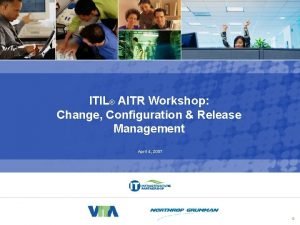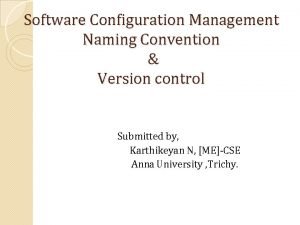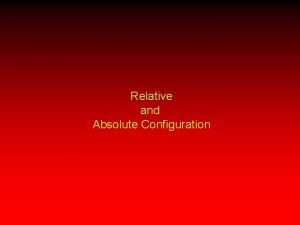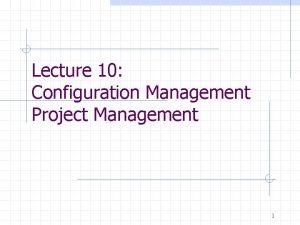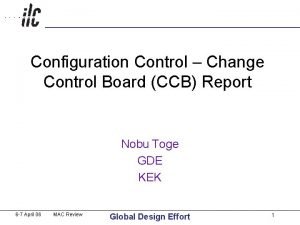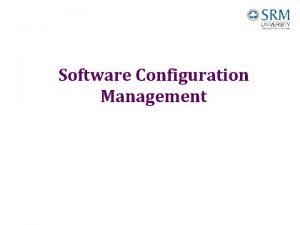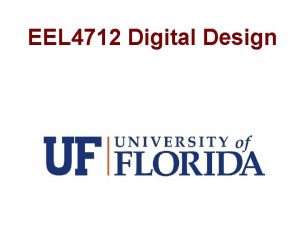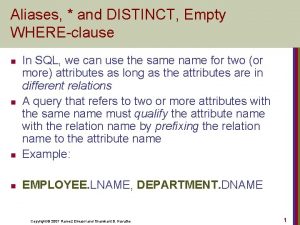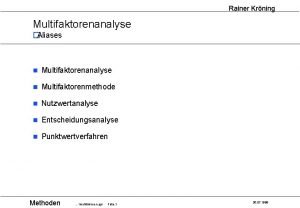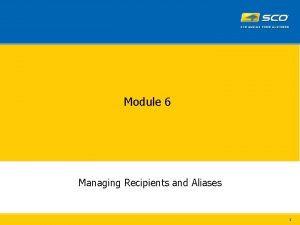Configuration Control Aliases change control change management Configuration












- Slides: 12

Configuration Control (Aliases: change control, change management)

Configuration Control • Configuration Control is the activity of managing the product(or project’s deliverables) and related documents, throughout the lifecycle of the product. An effective configuration control system ensures that • The latest approved version of the product and its components are used at all times. • No change is made to the product baselines without authorization. • A clear audit trail of all proposed, approved or implemented changes exists.

Configuration control is an important function of the configuration management discipline. Its purpose is to ensure that all changes to a complex system are performed with the knowledge and consent of management. The scope creep that results from ineffective or nonexistent configuration control is a frequent cause of project failure.

Configuration control tasks include initiating, preparing, analyzing, evaluating and authorizing proposals for change to a system (often referred to as "the configuration"). Configuration control has four main processes: 1. Identification and documentation of the need for a change in a change request 2. Analysis and evaluation of a change request and production of a change proposal 3. Approval or disapproval of a change proposal 4. Verification, implementation and release of a change.

The Configuration Control Process

Why Configuration Control is Important • Configuration control is an essential component of a project's risk management strategy. For example, uncontrolled changes to software requirements introduce the risk of cost and schedule overruns. • Scenario - Curse of the Feature Creep • A project misses several key milestones and shows no sign of delivering anything. • WHY? • The customer regularly talks directly to software developers asking them to make 'little changes' without consulting the project manager. • The developers are keen to show off the new technology they are using. They slip in the odd 'neat feature' that they know the customer will love. • Solution: Implement configuration control. Document all requests for change and have them considered by a Configuration Control Board.

The Elements of SCM Software Configuration Control - The evolution of a software system, in the language of SCM, is the development of baselines and incorporation of a series of changes into the baselines. - In addition to these changes, there are changes that occur during early stages of the system life cycle that may affect baselines that do not yet exist. - The role of the software configuration control is to provide the administrative mechanism for preparing, evaluating, approving or disapproving all change proposal throughout the system life cycle. - SCC focuses on managing changes to SCI’s (existing or to be developed) in all of their representations.

This process involves 3 basic ingredients: 1 - Documentation: administrative forms, supporting technical and administrative material. 2 - Configuration Control Board (CCB): organizational body formally evaluating and approving or disapproving a proposed change to the system. 3 - Procedures for controlling changes to a software system. The Engineering Change Proposal (ECP) is a major control document, contains information such as: - a description of the proposed change. - identification of the originating organization. - rationale for the change. - identification of the affected baselines and SCI’s (if appropriate). - specification of cost and schedule impacts.

Many automated tools support the control process such as the PSL’s (Program Support Libraries). - There automation for other functions such as library access control, software and documentation version maintenance, change recording, and document reconstruction. - These capabilities are available in systems such as SOFTTOOL’s change and configuration control environment. - PSL should support 3 main activities: code development, software management, and configuration control. - A PSL provides the support for code development: 1 - storage and maintenance of software documentation and code. 2 - support to program/compilation testing. 3 - support for the generation of program/system documentation.

Support to the management of the software development process involves the storage and output of programming data such as: 1 - collection and automatic reporting of management data related to program development. 2 - control over the integrity and security of the data in the PSL. 3 - separation of the clerical activity related to the programming process.

PSL provides support to the configuration control process through: 1 - access and change authorization control for all data in the library. 2 - control of software code releases. 3 - automatic program and document reconstruction. 4 - automatic change tracking and reporting. 5 - assurance of the consistency between documentation, code and listings.

A PSL has four major components: 1 - internal libraries in machine-readable form. 2 - external libraries in hardcopy form. 3 - computer procedures. 4 - office procedures.
 Change and configuration management
Change and configuration management Change configuration & release management
Change configuration & release management Software numbering conventions
Software numbering conventions What is absolute configuration
What is absolute configuration Number of chiral centres in morphine
Number of chiral centres in morphine Electron configuration vs noble gas configuration
Electron configuration vs noble gas configuration Difference between absolute and relative configuration
Difference between absolute and relative configuration Configuration management project management
Configuration management project management Configuration item
Configuration item Compatibility configuration coordination control
Compatibility configuration coordination control Change control board ccb
Change control board ccb Aircraft configuration management
Aircraft configuration management Software configuration management basics and standards
Software configuration management basics and standards

